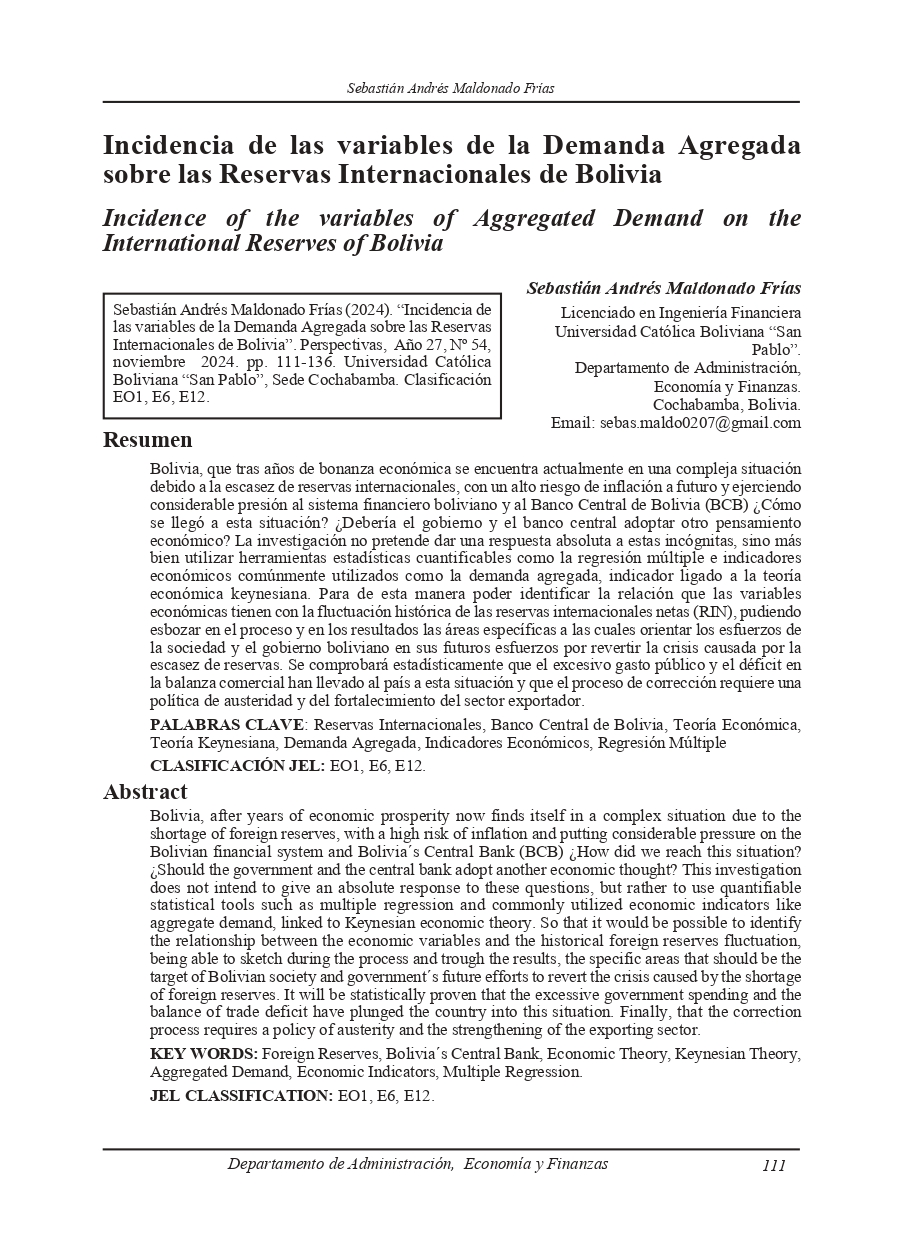Incidence of the variables of Aggregated Demand on the International Reserves of Bolivia
DOI:
https://doi.org/10.35319/av5myz34Keywords:
Foreign Reserves, Bolivia ́s Central Bank, Economic Theory, Keynesian Theory, Aggregated Demand, Economic Indicators, Multiple RegressionAbstract
Bolivia, after years of economic prosperity now finds itself in a complex situation due to the shortage of foreign reserves, with a high risk of inflation and putting considerable pressure on the Bolivian financial system and Bolivia ́s Central Bank (BCB) ¿How did we reach this situation? ¿Should the government and the central bank adopt another economic thought? This investigation does not intend to give an absolute response to these questions, but rather to use quantifiable statistical tools such as multiple regression and commonly utilized economic indicators like aggregate demand, linked to Keynesian economic theory. So that it would be possible to identify the relationship between the economic variables and the historical foreign reserves fluctuation, being able to sketch during the process and trough the results, the specific areas that should be the target of Bolivian society and government ́s future efforts to revert the crisis caused by the shortage of foreign reserves. It will be statistically proven that the excessive government spending and the balance of trade deficit have plunged the country into this situation. Finally, that the correction process requires a policy of austerity and the strengthening of the exporting sector.
Downloads
References
Aisenman, Joshua., & LEE, Jaewoo. (2007). International Reserves: Precautionary versus Mercantilist Views, Theory and Evidence. (s.l): Edición NBER.
Bhalla, Deepanshu (2014). “Difference between Adjusted RSquared and RSquared”. En: https://www.listendata.com/2014/08/adjusted-r-squared.html?utm_source=chatgpt.com
Bobbit, Zach (2019). “A Simple Guide to Understanding the FTest of Overall Significance in Regression” En: https://www.statology.org/asimpleguidetounderstandingtheftestofoverallsignificanceinregression/
Byjus. (2024). “Difference between Rsquared and Correlation” En: https://byjus.com/commerce/difference-between-r-squared-and-correlation/?utm_source=chatgpt.com
FASTERCAPITAL (2024). “Estadistica de Durbin Watson Evaluacion de la autocorrelacion en los modelos de regresión” En: https://fastercapital.com/es/contenido/Estadistica-de-Durbin-Watson--Evaluacion-de-la-autocorrelacion-en-los-modelos-de-regresion.html?utm_source=chatgpt.com
Frost, Jim. (2024). “How to Interpret Adjusted RSquared and Predicted RSquared in Regression Analysis”. En: https://statisticsbyjim.com/regression/interpret-adjusted-r-squared-predicted-r-squared-regression/?utm_source=chatgpt.com
Heakal, Reem. (2023). “What central banks do”. De: https://www.investopedia.com/articles/03/050703.asp#:~:text=Central%20banks%20carry%20out%20a,and%20lending%20throughout%20an%20economy
Kenton, Will (2023). “Durbin Watson Test: What It Is in Statistics, With Examples” De: https://www.investopedia.com/terms/d/durbin-watson-statistic.asp?utm_source=chatgpt.com
Laerd (2018). “Multiple Regression Analysis using SPSS Statistics”. De: https://statistics.laerd.com/spss-tutorials/multiple-regression-using-spss-statistics.php
Pettinger, Tejvan (2017). “Investment and Aggregate Demand”. De: https://www.economicshelp.org/blog/643/unemployment/investment¬and¬aggregate-demand/
Romero, Eva (2024). “Heterocedasticidad”.
Salmerón, Román. (2012). “Multicolinealidad” De: https://digibug.ugr.es/handle/10481/63357
Santaella, Jesús. (2023). “Demanda Agregada: ¿Qué es y por qué es importante calcularla?” De: https://economia3.com/demanda-agregada-que-es-importancia/
Santander. (2023). “What are central banks and why are they so important?” De: https://www.santander.com/en/stories/what-is-a-central-bank
Taylor, Sebastian (2024). “R-squared” De: https://investguiding.com/article/r-squared
Valtule, Ganesh (2024). “Breusch-Pagan Test: An Essential Tool in Econometrics”.

Downloads
Published
Issue
Section
License
Copyright (c) 2024 Revista Perspectivas

This work is licensed under a Creative Commons Attribution-NonCommercial-ShareAlike 4.0 International License.
La Revista Perspectivas de la Universidad Católica Boliviana, es una revista de acceso abierto, por lo tanto, es de libre acceso en su integridad. Está permitida su lectura, búsqueda, descarga, distribución y reutilización legal en cualquier tipo de soporte únicamente para fines no comerciales, siempre y cuando la obra sea debidamente citada.




